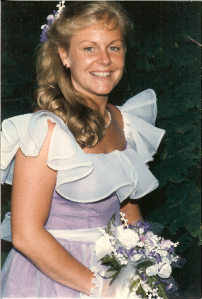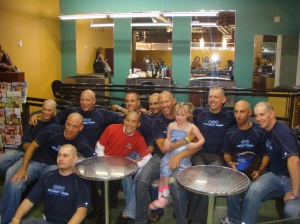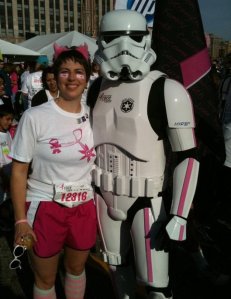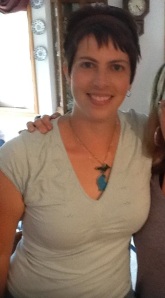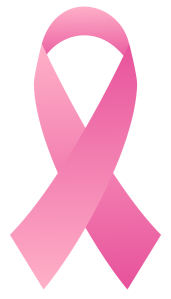 By Christina Venditti, Third Party Events Coordinator, Barbara Ann Karmanos Cancer Institute
By Christina Venditti, Third Party Events Coordinator, Barbara Ann Karmanos Cancer Institute
October has officially been sanctioned Breast Cancer Awareness Month since 1985. That means 31 days are completely devoted to celebrating the strength of women and men (yes, men get it too — 1 percent of breast cancer patients are men, to be exact) who have faced breast cancer. We try to think of clever ways to say “boob.” We dye our hair pink, we make pink drinks with cute names and we wear pink ribbons from head to toe — all to declare our allegiance to our team in the fight against breast cancer.
This October, Karmanos Cancer Institute was supported throughout the community by more than 60 breast cancer fundraising events and promotions. We felt the support from so many individuals, schools, organizations and corporations.
And there were so many bras! I mean, I saw bras decorated as aliens, fruit baskets and everything in between (and if you’re comparing aliens to fruit baskets, there should be a considerable amount of space in between). Bras were hung from trees, bras were bedazzled with Swarovski crystals and bras were worn by men (I tried to pretend this didn’t make me uncomfortable). Bras should become the official mascot of the month of October. They were collected in droves, and it was awesome.
It’s that type of funny, tongue-in-cheek, bra-tasic humor that makes October special. Breast cancer is a terrible disease, but with the support of fellow survivors, the faces of breast cancer stand tall throughout October.
But now that the month is over, it does not mean that cancer comes to a halt. October is only one month to celebrate one type of cancer. There are 11 other months and more than 100 other types of cancer to educate ourselves on, to advance treatment to and to muscle up our fight against.
Although awareness can be raised at any time throughout the year, here are some other cancer awareness months you may not have known about:
January – Cervical Health Awareness Month
This month was designated to highlight issues related to cervical cancer, HPV disease and the importance of early detection (NCCC). Karmanos Cancer Institute is home to the metro Detroit Breast and Cervical Cancer Control Program, which provides breast and cervical screenings to uninsured and underinsured women who qualify.
February – Clinical Trials Awareness Month
Clinical trials pave the way to new and more effective ways of detecting and treating cancer.
The Barbara Ann Karmanos Cancer Institute’s Phase I Clinical Trials program is one of only 14 National Cancer Institute-funded programs in North America. It is the only program of its kind in Michigan. Clinical trials are FDA-regulated and provide patients access to approximately 100 drugs not found elsewhere in Michigan.
March – Colorectal Cancer Awareness Month
According to the American Cancer Society, colorectal cancer is the third most common cancer, excluding skin cancers, diagnosed in both men and women in the United States. Chris4Life hosts the Scope it Out 5K to raise funds for colon cancer research at Karmanos Cancer Institute.
April – Testicular Cancer Awareness Month
Did you know that royal blue is the nationally recognized color associated with testicular cancer awareness? April also represents National Cancer Control month.
May – Melanoma/Skin Cancer Detection and Prevention Month
Skin cancer is the most common form of cancer in the United States. Fortunately, skin cancer is also one of the most preventable forms of cancer (Skin Cancer Foundation). As the sun comes out, so should the sunscreen. There is even a special “Don’t Fry Day” on May 23. May is a great month for benefit golf outings and outdoor events, like races or sports games. May is also Leave a Legacy Month, which encourages charitable giving through wills and bequests.
June – Cancer Survivor’s Month
June is a month entirely devoted to celebrating our courageous cancer survivors. At Karmanos, we have programs and support groups to help survivors and current patients adjust to new lifestyles and continue to grow.
July – Sarcoma Cancer Awareness Month
Sarcoma is one of the rarer forms of cancer. Sarcomas are rare tumors, with less than 10,000 new cases diagnosed each year, which develop in an individual’s soft tissue or bone. For those who are connected to sarcoma, July is an excellent month to educate the community and raise funds to advance research.
September – Prostate Cancer Awareness Month
Aside from non-melanoma skin cancer, prostate cancer is the most common cancer among men in the United States (CDC). September is also Ovarian Cancer Awareness Month.
November – Lung Cancer Awareness Month
Riding on the wake of October’s Breast Cancer Awareness, Lung Cancer Awareness month is sometimes silent. Wonderful organizations like the Gianni Ferrarotti Lung Cancer Foundation help fund lung cancer research at Karmanos. With the many research projects at Karmanos, November is a great time to raise lung cancer awareness before the holidays begin. November is also Pancreas Cancer Awareness Month.
December – Year-End Giving and Adopt-a-Family
At this special time of year, we ask supporters to consider making a year-end gift, which will have an immediate impact on the lives of those facing and living with cancer.
In December, Karmanos also offers an Adopt-a-Family program. With the holidays in clear view, it’s a wonderful feeling to help those in need. Our Adopt-a-Family program at Karmanos helps the families of certain patients get through the holidays.
With the above information, we hope you’ll be inspired to support the many different types of cancer activities and events with us. For more information on our Friends Raising Funds program, or to find out how to get involved, please contact Christina Venditti at 313-576-8112.
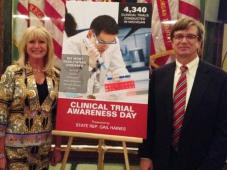

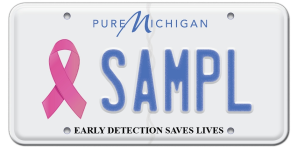 Last year, the Michigan legislature passed Senate Bill 101, and on December 19, 2013, Governor Rick Snyder signed it into law. Seems like old news, right? Just bear with me for a few more sentences.
Last year, the Michigan legislature passed Senate Bill 101, and on December 19, 2013, Governor Rick Snyder signed it into law. Seems like old news, right? Just bear with me for a few more sentences.